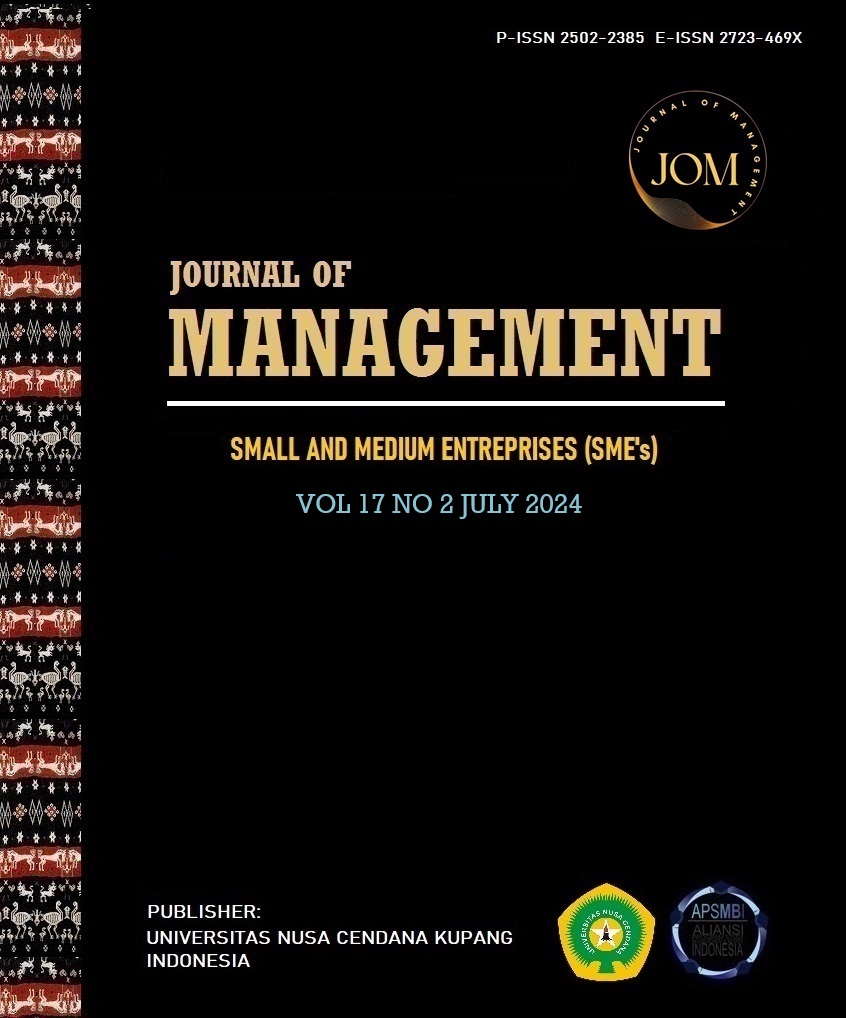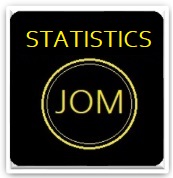SYSTEMATIC LITERATURE REVIEW (SLR): PERUBAHAN PERAN CHIEF FINANCIAL OFFICER (CFO) DALAM MENGOPTIMALKAN PENGGUNAAN TEKNOLOGI, DAN KETEPATAN ALAM PENGAMBILAN KEPUTUSAN STRATEGIS
Abstract
This research aims to review the CFO's role's evolution and technology's impact on the modern CFO function. The study uses a Systematic Literature Review (SLR) to investigate the Chief Financial Officer's (CFO) changing role in optimizing the use of the latest technology and process automation. The SLR findings indicate the CFO's role has shifted from a technical finance role to a business leader providing strategic recommendations and financial risk analysis. The research found that by utilizing the latest technology, CFOs can optimize operational efficiency and support faster, more accurate business decision-making. Based on upper echelon theory, the CFO's characteristics affect the company's decisions. Therefore, companies should consider CFOs' experience and education in supporting their strategic role. The study's originality lies in discussing the CFO's role development in the digital era and the impact of the latest technology on strategic decision-making.
Keywords: Chief Financial Officer; Use of Technology; Operational Efficiency; Decision Making
Downloads
References
https://doi.org/10.1080/23311975.2023.2275867
Alrazi, B., Mat Husin, N., Mohd Ali, I., Nik Azman, N. A. N., & Mohd Nor, M. N. (2022). Chief Financial Officers and Corporate Sustainability: A Literature Review and Research Agenda. IOP Conference Series: Earth and Environmental Science, 943(1). https://doi.org/10.1088/1755-1315/943/1/012032
Amoozegar, A., Pukthuanthong, K., & Walker, T. J. (2017). On the role of the chief risk officer and the risk committee in insuring financial institutions against litigation. Managerial Finance, 43(1), 19–43. https://doi.org/10.1108/MF-05-2016-0127
Busalim, A. H., & others. (2016). Understanding social commerce: A systematic literature review and directions for further research. International Journal of Information Management, 36(6), 1075–1088.
Bussin, M. H. R., & Ncube, M. (2017). Chief executive officer and chief financial officer compensation relationship to company performance in state-owned entities. South African Journal of Economic and Management Sciences, 20(1), 1–10. https://doi.org/10.4102/sajems.v20i1.1644
Chakrabarty, B., Gupta, V. K., Mortal, S., & Guo, X. (2017). CFO Gender and Financial Statement Irregularities. Academy of Management Proceedings, 2017(1), 10419. https://doi.org/10.5465/ambpp.2017.10419abstract
Daff, L. (2021). Chief financial officers’ perceptions of their roles inside nonprofit organizations. Financial Accountability and Management, 37(1), 3–19. https://doi.org/10.1111/faam.12233
de Geus, C. J. C., Ingrams, A., Tummers, L., & Pandey, S. K. (2020). Organizational citizenship behavior in the public sector: A systematic literature review and future research agenda. Public Administration Review, 80(2), 259–270.
Duong, L., Evans, J., & Truong, T. P. (2020). Getting CFO on board – its impact on firm performance and earnings quality. Accounting Research Journal, 33(2), 435–454. https://doi.org/10.1108/ARJ-10-2018-0185
Ferramosca, S., & Allegrini, M. (2021). Impairment or amortization of goodwill? An analysis of CFO perceptions of goodwill accounting. European Management Journal, 39(6), 816–828. https://doi.org/10.1016/j.emj.2021.03.001
Firk, S., Gehrke, Y., Richter, S., & Wolff, M. (2023). CFO Career Concerns and Strategic Decisions: An Empirical Analysis of M&As. European Accounting Review. https://doi.org/10.1080/09638180.2023.2291405
Firmansyah, E. A., & Umar, U. H. (2023). Metaverse in business research: a systematic literature review. Cogent Business and Management, 10(2). https://doi.org/10.1080/23311975.2023.2222499
Habib A, H. M. (2013). CEO/CFO characteristics and fnancial reporting quality: A review.
Harymawan, I., Minanurohman, A., Nasih, M., Shafie, R., & Ismail, I. (2023). Chief financial officer’s educational background from reputable universities and financial reporting quality. Journal of Accounting and Organizational Change, 19(4), 566–587. https://doi.org/10.1108/JAOC-12-2021-0195
Hiebl, M. R. W. (2015). Agency and stewardship attitudes of chief financial officers in private companies. Qualitative Research in Financial Markets, 7(1), 4–23. https://doi.org/10.1108/QRFM-12-2012-0032
Hiebl, M. R. W. (2017). Finance managers in family firms: an upper-echelons view. Journal of Family Business Management, 7(2), 207–220. https://doi.org/10.1108/JFBM-07-2016-0014
Hiebl, M. R. W. (2023). Sample Selection in Systematic Literature Reviews of Management Research. Organizational Research Methods, 26(2), 229–261.
https://doi.org/10.1177/1094428120986851
Hiebl, M. R. W., Gärtner, B., & Duller, C. (2017). Chief financial officer (CFO) characteristics and ERP system adoption: An upper-echelons perspective. Journal of Accounting and Organizational Change, 13(1), 85–111. https://doi.org/10.1108/JAOC-10-2015-0078
Hossain, S., & Monroe, G. S. (2015). Chief Financial Officers’ Short- and Long-term Incentive-based Compensation and Earnings Management. Australian Accounting Review, 25(3), 279–291. https://doi.org/10.1111/auar.12059
Hrazdil, K., Li, J., Lobo, G., & Zhang, R. (2024). CFO facial beauty and bank loan contracting. Accounting and Finance, 64(1), 975–1009. https://doi.org/10.1111/acfi.13168
Ihksan, A., Risma, A., Wa, N., Sri, O., Rizqy, A., Alam, I., Ilah, N., Ernasari, P., & Ramli, R. (2023). Studi Literatur (Systematic, Narrative, Scoping, Argumentative, Theoritical) (Vol. 1).
Iseke, A., & Pull, K. (2019). Female Executives and Perceived Employer Attractiveness: On the Potentially Adverse Signal of Having a Female CHRO Rather Than a Female CFO. Journal of Business Ethics, 156(4), 1113–1133. https://doi.org/10.1007/s10551-017-3640-1
Iskandar-Datta, M., & Shekhar, S. (2020). Do insider CFOs deliver better acquisition performance? Journal of Business Research, 118, 240–252.
https://doi.org/https://doi.org/10.1016/j.jbusres.2020.06.040
Ismail, I., Shafie, R., & Ismail, K. N. I. K. (2020). Current Trends and Future Directions on Women CEOs/CFOs and Financial Reporting Quality. Journal of Asian Finance, Economics and Business, 7(11), 679–687.
https://doi.org/10.13106/jafeb.2020.vol7.no11.679
Jiang, T., Wang, Z., Goto, S., & Zhang, F. (2020). CEO and CFO risk-taking incentives and earnings guidance. Applied Economics Letters, 27(15), 1256–1259. https://doi.org/10.1080/13504851.2019.1676865
Kuhail, M. A., Alturki, N., Alramlawi, S., & Alhejori, K. (2023). Interacting with educational chatbots: A systematic review. In Education and Information Technologies (Vol. 28, Issue 1). Springer US. https://doi.org/10.1007/s10639-022-11177-3
Liu, X., Yang, J., Di, R., & Li, M. (2022). CFO Tenure and Classification Shifting: Evidence from China. Emerging Markets Finance and Trade, 58(6), 1578–1589. https://doi.org/10.1080/1540496X.2021.1904879
Lopes, A. V., & Farias, J. S. (2022). How can governance support collaborative innovation in the public sector? A systematic review of the literature. International Review of Administrative Sciences, 88(1), 114–130.
Martins, E. J., & Belfo, F. P. (2023). Major concerns about Enterprise Resource Planning (ERP) systems: A systematic review of a decade of research (2011-2021). Procedia Computer Science, 219, 378–387. https://doi.org/10.1016/j.procs.2023.01.303
Nerantzidis, M., Pazarskis, M., Drogalas, G., & Galanis, S. (2022). Internal auditing in the public sector: a systematic literature review and future research agenda. Journal of Public Budgeting, Accounting and Financial Management, 34(2), 189–209. https://doi.org/10.1108/JPBAFM-02-2020-0015
O’Mahoney, L. L., Routen, A., Gillies, C., Ekezie, W., Welford, A., Zhang, A., Karamchandani, U., Simms-Williams, N., Cassambai, S., Ardavani, A., Wilkinson, T. J., Hawthorne, G., Curtis, F., Kingsnorth, A. P., Almaqhawi, A., Ward, T.,
Ayoubkhani, D., Banerjee, A., Calvert, M., … Khunti, K. (2023). The prevalence and long-term health effects of Long Covid among hospitalised and non-hospitalised populations: A systematic review and meta-analysis. EClinicalMedicine, 55(December 2022), 1–10. https://doi.org/10.1016/j.eclinm.2022.101762
Ojeka, S. A., Adegboye, A., Adegboye, K., Alabi, O., Afolabi, M., & Iyoha, F. (2019). Chief financial officer roles and enterprise risk management: An empirical based study. Heliyon, 5(6), e01934. https://doi.org/10.1016/j.heliyon.2019.e01934
Roberts, L., Hassan, A., Elamer, A., & Nandy, M. (2021). Biodiversity and extinction accounting for sustainable development: A systematic literature review and future research directions. Business Strategy and the Environment, 30(1), 705–720. https://doi.org/10.1002/bse.2649
Sablinskiene, R. (2021). Digitalization of Corporate Finance: How Finance 4.0 is changing the role of Chief Financial Officer (CFO)? May, 1–53. https://www.diva-portal.org/smash/get/diva2:1566156/FULLTEXT01.pdf
Salih, S., Hamdan, M., Abdelmaboud, A., Abdelaziz, A., Abdelsalam, S., Althobaiti, M. M., Cheikhrouhou, O., Hamam, H., & Alotaibi, F. (2021). Prioritising organisational factors impacting cloud ERP adoption and the critical issues related to security, usability, and vendors: A systematic literature review. Sensors, 21(24).
https://doi.org/10.3390/s21248391
Sandner, P., Lange, A., & Schulden, P. (2020). The role of the CFO of an industrial company: An analysis of the impact of blockchain technology. Future Internet, 12(8), 1–16. https://doi.org/10.3390/FI12080128
Sardo, Filipe; Alves, M. (2018). ERP systems and accounting: A systematic literature review. https://proxy.univh2c.ma:2076/record/display.uri?eid=2-s2.0-85049190703&origin=resultslist&sort=plf-f&src=s&sid=eb028f7f2264efae760dea695c68eab4&sot=b&sdt=cl&cluster=scosubjabbr%252C%2522BUSI%2522%252Ct%252Bscoexactkeywords%252C%2522Enterprise+Resource+Pl
Schobel, K., & Pond, G. (2020). Public CFO competencies – A National Defence case study examining the balance between financial and strategic priorities. Canadian Public Administration, 63(2), 229–246. https://doi.org/10.1111/capa.12366
Sun, J., Kent, P., Qi, B., & Wang, J. (2019). Chief financial officer demographic characteristics and fraudulent financial reporting in China. Accounting and Finance, 59(4), 2705–2734. https://doi.org/10.1111/acfi.12286
Yu, H., & Huang, W. (2022). Chief Financial Officer Functional Diversity and the Timeliness of Annual Reports: A Comparative Study of Firms With Different Ownership Types. Frontiers in Psychology, 13(May), 1–11. https://doi.org/10.3389/fpsyg.2022.889007
Zhao, X., & Ma, H. (2017). Chief Executive Officer Succession and Financial Constraints: Evidence from China. Asia-Pacific Journal of Financial Studies, 46(4), 583–608. https://doi.org/10.1111/ajfs.12181
Zhao, Y., Xiong, J., Wang, J., & Ye, N. (2022). CFO Gender, Corporate Risk-Taking, and Information Disclosure Violations. Frontiers in Psychology, 13(July), 1–16. https://doi.org/10.3389/fpsyg.2022.902472

 Asri Usman(1)
Asri Usman(1)



